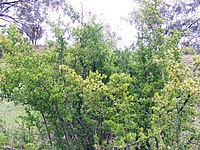
Photo from wikipedia
Abstract The fruits of three Lycium barbarum genotypes (HZR1, HZR2, HZR3) and a Lycium chinense genotype (M1 ALTUNI) harvested at various ripening stages (green, unripe, ripe) were compared based on… Click to show full abstract
Abstract The fruits of three Lycium barbarum genotypes (HZR1, HZR2, HZR3) and a Lycium chinense genotype (M1 ALTUNI) harvested at various ripening stages (green, unripe, ripe) were compared based on some pomological properties (fruit length, width, weight, colour, total soluble solid content and titratable acidity) and chemical compounds (sugars, organic acids, vitamin C). Glucose was the predominant sugar followed by fructose and sucrose, respectively, except at the green maturation stage. The results suggest that the best results for all genotypes and ripening stages were provided by the M1 ALTUNI genotype in terms of sugar contents. Succinic acid was the most abundant acid followed by citric and malic acid in all goji berry genotypes. If goji berry fruits are to be used for pharmacologic purposes, the most appropriate consumption stage is the green stage for organic acids and the dried stage for sugar, total soluble solids and L-ascorbic acid content.
Journal Title: Journal of Food Composition and Analysis
Year Published: 2021
Link to full text (if available)
Share on Social Media: Sign Up to like & get
recommendations!